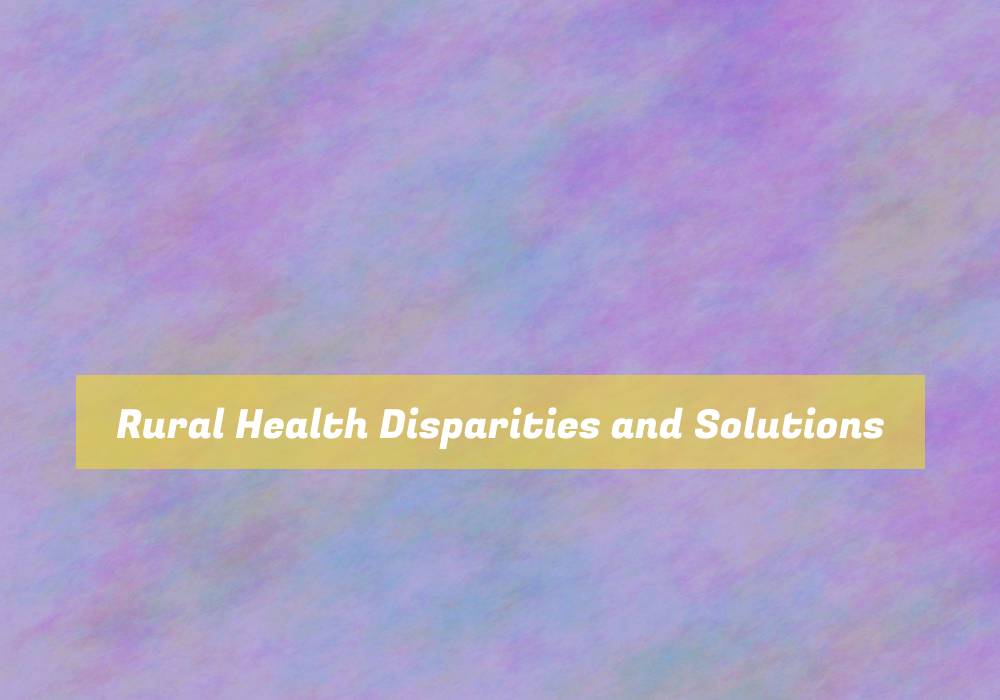Rural Health Disparities and Solutions
Did you know that rural residents are 5% more likely to die from preventable causes compared to their urban counterparts?
The disparity in healthcare access and outcomes between rural and urban areas is a pressing issue that demands attention. But what are the underlying reasons for this disparity, and what innovative solutions are being implemented to address these challenges?
LetG??s explore the complex landscape of rural health disparities and the promising strategies aimed at promoting health equity in these underserved areas.
Understanding Rural Health Disparities
To understand rural health disparities, itG??s important to recognize the unique challenges faced by individuals in rural areas when accessing healthcare.
In rural areas, access to healthcare facilities is often limited, with fewer hospitals and medical professionals available. This scarcity can result in longer travel times to reach healthcare providers, leading to delays in receiving necessary medical attention.
Additionally, rural areas often have lower income levels and higher rates of uninsured individuals, making it difficult for residents to afford healthcare services. The shortage of healthcare providers in rural areas also means that those who do seek medical care may encounter longer wait times for appointments and treatments.
Furthermore, the lack of specialized medical services in rural areas can result in patients needing to travel long distances to access certain treatments, causing additional financial and logistical burdens. The combination of these factors contributes to rural health disparities, as individuals in these areas face significant obstacles in obtaining timely and affordable healthcare.
Understanding these challenges is crucial in developing effective solutions to address rural health disparities and ensure that all individuals have access to the healthcare they need.
Barriers to Accessing Healthcare
Addressing the challenges faced in rural areas to access healthcare, itG??s crucial to recognize the barriers that individuals encounter when seeking medical services. One major barrier is the geographic distance to healthcare facilities. In rural areas, medical facilities are often few and far between, requiring individuals to travel long distances to receive care. This can be particularly challenging for those without access to reliable transportation, leading to delayed or forgone medical treatment.
Another significant barrier is the shortage of healthcare providers in rural areas. Many rural communities struggle to attract and retain healthcare professionals, resulting in limited availability of medical services. This shortage not only affects the accessibility of primary care but also specialty care, forcing individuals to seek treatment outside of their local communities.
Additionally, financial constraints can pose a significant obstacle to accessing healthcare in rural areas. Limited financial resources and lack of health insurance coverage can deter individuals from seeking necessary medical attention, leading to unmet healthcare needs.
Lastly, inadequate health literacy and awareness about available healthcare services can prevent individuals from seeking timely medical care, exacerbating health disparities in rural areas. Efforts to address these barriers must include strategies to improve transportation options, expand the healthcare workforce in rural areas, increase financial assistance programs, and enhance health education initiatives to ensure equitable access to healthcare for all rural residents.
Innovative Solutions and Interventions
Amidst the challenges of rural healthcare access, innovation stands as a beacon of hope, offering creative solutions to bridge the gap in medical services. One promising intervention is the use of telemedicine, which enables individuals in remote areas to consult with healthcare professionals through video calls, reducing the need for long and often costly travel.
Mobile health clinics are another innovative solution, bringing medical services directly to rural communities. These clinics offer a range of services, from preventive care to chronic disease management, addressing the healthcare needs of underserved populations.
Furthermore, the use of community health workers has shown great promise in rural areas. These individuals, often from the same community, are trained to provide basic healthcare services, health education, and support to community members. This approach not only improves access to care but also fosters trust and understanding within the community.
Innovative financing models, such as pay-for-performance and value-based care, are also being explored to incentivize healthcare providers to deliver high-quality care in rural areas. These models aim to improve health outcomes while controlling costs, ultimately ensuring that rural residents receive the care they need.
Promoting Health Equity in Rural Areas
Promoting health equity in rural areas requires a multifaceted approach that addresses the unique challenges faced by these communities.
Access to healthcare is a critical issue in rural areas, where geographic isolation and a shortage of healthcare facilities and providers can impede the delivery of medical services. To address this, telemedicine and mobile clinics can be utilized to bridge the gap and bring essential healthcare services directly to rural residents.
Additionally, thereG??s a need to focus on socioeconomic factors that contribute to health disparities. This involves addressing poverty, improving access to healthy food options, and creating economic opportunities within rural communities.
Education and outreach programs tailored to the specific needs of rural populations are also essential for promoting health equity. By raising awareness about preventive care, chronic disease management, and mental health resources, these initiatives can empower individuals to take control of their health.
Ultimately, promoting health equity in rural areas requires a comprehensive strategy that encompasses healthcare access, socioeconomic factors, and community education to ensure that all individuals, regardless of location, have the opportunity to lead healthy lives.
Conclusion
In conclusion, addressing rural health disparities requires recognizing the barriers to accessing healthcare and implementing innovative solutions.
By promoting health equity in rural areas, we can work towards closing the gap in healthcare outcomes.
ItG??s important to continue advocating for resources and support to ensure that all individuals, regardless of their location, have access to the healthcare they need to thrive.







This is a really important topic, and I appreciate you shedding light on it. It makes me think about my own experiences growing up in a small town where access to healthcare was a constant concern. We had one small clinic, and if you needed anything more serious, you were looking at a long drive to a city, which wasn’t just inconvenient but often a bit daunting, especially for older residents or those without reliable transportation.
It sounds like your experiences really highlight the challenges many face in small towns when it comes to healthcare. That long drive to a city for more comprehensive services isn’t just a logistical hurdle; it can create a barrier to receiving timely care, which is crucial, especially for older residents or those who may struggle with transportation.
You make such a good point about the logistical challenges of healthcare in small towns. That long drive really can feel overwhelming, especially when every minute counts for someone dealing with health issues. I’ve spoken with older neighbors who have shared how that commute not only impacts their physical health but also adds so much stress to their lives. It’s one thing to navigate everyday tasks, but when you layer on the need for more comprehensive medical care, it can feel insurmountable.
I recently came across some insights on how access to healthcare varies globally, which really resonates with the challenges faced in small towns—especially the struggle for timely services that many residents encounter.
‘Breaking Barriers: Access to Healthcare in Different Parts of the World’
https://www.global-ehealth-forum.com/2023/02/09/breaking-barriers-access-to-healthcare-in-different-parts-of-the-world/.
You’ve beautifully captured the heart of the issue. The long drives to access healthcare can be such a significant burden, especially for older individuals who are already facing various health challenges. That added stress can indeed create a ripple effect on their overall well-being.
You make a really relevant point about the long drives to access healthcare. It’s easy to overlook how something like transportation can compound the challenges faced by older individuals. I’ve seen this firsthand with my grandparents, who often had to travel quite a distance for routine check-ups. It was stressful for them—not just physically, but emotionally, too. They would talk about feeling isolated when they couldn’t visit their familiar doctors or facilities.
I appreciate your thoughts on this. The long drives to access healthcare really do weigh heavily, especially for older individuals. I’ve seen it firsthand with my own grandparents. They often put off appointments simply because the travel itself feels like a hurdle, not to mention how tiring it can be for them after a long day.
I found an insightful piece that delves into how healthcare startups can uniquely address these challenges, particularly for older individuals facing those long journeys for care.
‘Unique Value Proposition for Your UK Healthcare Startup’
https://www.global-ehealth-forum.com/2025/05/30/unique-value-proposition-for-your-uk-healthcare-startup/.
You’ve touched on such an important aspect of healthcare access. The long drives to access healthcare really can be a burden, particularly for older individuals; it’s not just about the distance but also the stress and fatigue that can come along with it. I’ve seen this firsthand with my grandparents. They often had to plan their whole day around a doctor’s appointment, factoring in travel time, waiting rooms, and the energy it took just to get there.
You’ve touched on a vital aspect of healthcare that often gets overlooked, especially in discussions focused solely on urban settings. The fact that so many individuals in small towns have to contend with physical and emotional stress while driving long distances for care is significant. It goes beyond just logistics; it deeply affects their overall quality of life. The layers of stress added by lengthy commutes can exacerbate existing health conditions, making it all the more crucial that we address these disparities.
You’ve articulated a really important concern about healthcare access in rural areas. The long distances that people in small towns have to travel for medical care indeed create a host of additional challenges. It’s not just about the physical act of driving; there’s a mental toll that comes with it, too. I recently read about a community health initiative in a rural area that introduced telehealth services, which seems to address some of these accessibility issues. It provides patients with a way to receive care without the stress of a lengthy commute.
You’ve highlighted a critical aspect of rural healthcare that resonates deeply with many, myself included. The distance people have to travel for medical care isn’t just a logistical issue; it’s a barrier that impacts overall well-being and peace of mind. Long drives can be exhausting, and when you factor in the frustrations of navigating unfamiliar roads or unreliable weather, it can really amplify feelings of anxiety and stress.
You raise a valid point about the mental burden of travel for healthcare, which often gets overshadowed by the logistical challenges. Telehealth has been a game changer for many. However, it’s worth considering that while some people may find virtual visits easier, others might struggle with technology or lack reliable internet access, particularly in very remote areas. It’s not a one-size-fits-all solution.
You make a great point about the tech divide. It’s like that awkward moment when everyone shows up to a party in costume, and one person strolls in wearing casual jeans. Telehealth is a game changer, but it does assume everyone has a backstage pass to the internet.
You bring up such an important angle! It’s true that telehealth has transformed the way many of us access healthcare, but the technology gap is a real concern. For folks in remote areas or those who aren’t tech-savvy, virtual visits can feel more like a hurdle than a help. The last thing we want is for these advancements to unintentionally leave anyone behind.
You’ve pointed out a vital aspect of healthcare that often gets overlooked, especially in discussions focused solely on urban settings. It’s interesting how the emphasis on urban healthcare can sometimes overshadow the significant needs of those living in rural areas. This issue of distance is profound—not only is it about getting to appointments, but the journey itself can be a source of anxiety and weariness.
I recently came across some insights that shed light on the often-overlooked financial disparities in healthcare, especially as they relate to the experiences of those in rural areas facing significant challenges.
‘Healthcare Budget Variance: Essential Insights Explained’
https://www.global-ehealth-forum.com/2025/05/26/healthcare-budget-variance-essential-insights-explained/.
You’ve really hit the nail on the head with how those long drives can feel like an Olympic event, especially when you’re dealing with a health issue. I mean, juggling everyday tasks is one thing, but throw in a trip to the doctor’s office that feels more like a trek to the North Pole, and it’s a whole different ball game. It’s almost like a cruel game show: “How many health issues can you handle before the stress of the drive sends you over the edge?”
Navigating those long drives can be a real test, can’t it? It’s like you’re packing up not just your essentials but all the little worries that come with health issues. Each mile can feel heavier when you’re juggling everything else on your mind.
You really captured the situation well—those long drives can feel overwhelming, especially when you’re already juggling health concerns. It’s true that everyday tasks can often feel manageable, but then you factor in a trip to the doctor’s office, and it turns into this whole expedition. It’s like you sign up for a game, but the stakes are way higher than any game show.
It’s so true how those long drives can transform an ordinary day into a full-blown expedition. I often think about how the mental and emotional load can be just as heavy as the physical one, especially when health concerns are in play. Preparing for a doctor’s appointment, you start to mentally map out everything: the questions you want to ask, the concerns you want to address, and even the possible routes to avoid traffic. It feels like you’re gearing up for a significant mission rather than just a simple trip.
I recently came across an article that dives into how UK healthcare startups can carve out their unique space, and it really resonated, especially considering how those daunting trips to the doctor can throw everything off balance.
‘Unique Value Proposition for Your UK Healthcare Startup’
http://www.global-ehealth-forum.com/2025/05/30/unique-value-proposition-for-your-uk-healthcare-startup/.
You’ve perfectly captured a reality many face. That experience of turning a simple doctor’s visit into an expedition is all too familiar. The logistics of getting there often add layers of complexity—the planning, the packing of essentials, and the mental preparation needed can feel more daunting than the appointment itself. When health issues come into play, that journey can wear you down before you even arrive.
I completely relate to that experience. The journey to a doctor’s appointment often feels like a mini-adventure, right? It’s not just about the destination but all the behind-the-scenes effort that goes into making it happen. I’ve had days where I spent more time strategizing how to get to the appointment—what time to leave, what route to take, even what to bring along—than I did actually at the appointment itself. It’s as if you’re preparing for a big trip rather than a simple check-up.
You’re so right about that mini-adventure feel. It’s almost like an expedition each time, trying to figure out the best plan. I remember a time when I had to visit a specialist, and I turned the whole trip into a puzzle—mapping out public transport routes and timings like I was plotting a treasure hunt.
You’ve touched on something that’s really at the heart of the healthcare conversation, especially in smaller communities. Those long drives can be a real grind, can’t they? It’s not just about the distance; it’s everything that comes with it—the stress, the time away from work or family, even the physical toll of just getting there. For older folks, who might already be managing multiple health issues, that commute can feel like a mountain to climb rather than just a drive to the clinic.
Your experiences really highlight a crucial aspect of healthcare in smaller communities that often gets overlooked. Growing up in a small town certainly comes with its own set of charms, but reliable access to healthcare can be a real challenge. The situation you describe—relying on a single clinic and making long treks for more serious care—resonates with many people in similar rural settings.
It’s true, the charm of small towns can sometimes hide the struggles people face when it comes to healthcare. Relying on a single clinic means you get to know the staff well, but it can also create a sense of vulnerability when more serious health issues arise. I remember growing up, my family and I relied heavily on our local clinic, and there were definitely moments when it felt like a gamble. Trips to the nearest hospital could mean an hour or more on the road, and in a small community, there’s a certain pressure to tolerate discomfort rather than make that journey for what might seem like a minor issue.
You’re spot on about the complexities of healthcare in smaller communities. Growing up in a town where the clinic served as the primary lifeline, I can relate deeply to the challenges. The charm of a close-knit environment sometimes masks the reality that when it comes to health, resources can be painfully limited.
Your experiences resonate deeply, and it’s striking how many people share similar stories. In small towns, healthcare challenges can feel like a significant hurdle, especially when you’re relying on just one clinic. That long drive to the city really adds to the stress for many, particularly for older residents or those without reliable transport.
It’s definitely true that the healthcare landscape can feel especially daunting in small towns, and your point about relying on just one clinic really hits home. There’s a certain comfort in familiar faces at a local clinic, but that can quickly turn into a bottleneck when there are ongoing challenges or when specialty care is needed. The reliance on just one clinic can lead to a sense of vulnerability for many, and that stress is amplified when a drive to the city is involved.
You hit the nail on the head. Those long drives really can take a toll, especially for older folks who might find navigating the city overwhelming. I’ve seen it firsthand—people missing appointments simply because getting there felt like too big of a challenge. It’s not just about distance; it’s the uncertainty and the time away from the comforts of home that can be daunting.
You hit the nail on the head with that observation. Small-town life can feel like a game of healthcare roulette, where the odds are firmly stacked against you if you need more than a sneeze diagnosed. You put your faith in that one clinic, and suddenly you’re on a first-name basis with the receptionist and basically a family member to the waiting room’s houseplants.
It sounds like you experienced firsthand the complexities of accessing healthcare in a small town. Having only one clinic must have added a layer of stress for you and your neighbors, especially knowing that anything beyond routine care required a trek to the city. Those long drives can feel isolating, particularly for older residents or anyone without dependable transportation.
You’re spot on about the stress of navigating healthcare in a small town. It’s easy to overlook how much logistics impact people’s access to care. That single clinic often feels like a lifeline, especially when you know it’s not equipped for more complicated issues.
I really resonate with what you’ve shared about the challenges of accessing healthcare in a small town. It’s true that the logistics can really shape our experiences and perceptions of care. I’ve seen similar dynamics play out in my community, where there’s often just one clinic that acts as the go-to for everything from routine check-ups to more complex issues.
I hear you on that. The dynamics in small towns can be really challenging when it comes to healthcare. Having just one clinic can create a sense of community, but it can also lead to issues like long wait times or limited specialties. I remember when my family had to rely on our local clinic for pretty much everything; the staff were amazing and always tried their best, but you could see the strain on them when complex cases came in.
You’ve hit the nail on the head with your experience in your community! It’s a bit like being stuck in a reality show where your only option for medical care is the local clinic—complete with a cast of characters who know your medical history better than you do.
I really appreciate you sharing your perspective. It’s interesting how the logistics of healthcare in small towns really do shape how we experience it. The reliance on that one clinic must create a unique dynamic in your community, especially when it comes to continuity of care. I wonder how that affects the relationships between patients and providers.
It’s interesting to hear about your experiences growing up in a small town. Access to healthcare is a challenge many communities face, particularly in rural areas where resources are limited. The situation you describe, relying on a small clinic and the daunting trek to a larger facility, highlights a broader issue.
It’s interesting to hear about your experiences growing up in a small town. That challenge of accessing healthcare is something many people can relate to. It’s not just about the distance but the barriers it creates for those who need immediate care or ongoing treatment. It’s so true that older residents or those without reliable transportation feel that burden more acutely.
It’s interesting to hear your experiences growing up in a small town with limited healthcare access. That situation is more common than many realize, and it really brings to light how geography can influence health outcomes.
It really resonates with me when you mention the challenges of growing up in a small town, especially regarding healthcare access. I’ve heard many similar stories, and it’s alarming how much that impacts not just health outcomes but also community well-being. The reliance on a single clinic can really make people feel vulnerable, and as you pointed out, that’s especially true for older residents who might not have the means to travel far.
Your thoughts really highlight an important issue. Growing up in a small town often means that healthcare becomes a community lifeline, and when that lifeline is stretched thin, people feel it deeply. It’s more than just an inconvenience — it shapes lives and relationships.
You’ve touched on something so crucial that often gets overlooked in discussions about healthcare—accessibility. Growing up in a small town comes with its own unique set of challenges, and the struggle for adequate healthcare resources is right at the top of that list. It’s not just about having a clinic nearby; it’s the reality that a serious health issue could mean hours of travel, which can feel incredibly isolating.